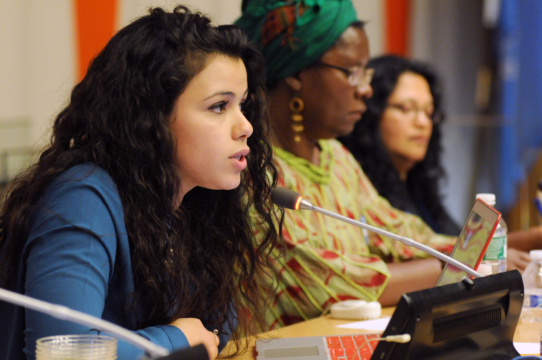Is Central America Losing the Battle against Drug Violence?
Are Central American governments making any strides against violence? How is the violence affecting businesses and the economies of the isthmus?
Q: The number of women imprisoned for federal crimes in Mexico has soared by 400 percent since 2007, bringing the total number of women in prison past 10,000, The New York Times reported Aug. 13. What roles are women playing in the country's brutal drug trafficking war? How has their involvement changed in recent years? Is the increase merely a symptom of cartels' infiltration into Mexican life or are other factors contributing to the rise in women incarcerated for federal crimes?
A: Guadalupe Correa-Cabrera, assistant professor of government at the University of Texas at Brownsville: "The role of women in organized crime-such as drug trafficking-has been increasing in the last few years, and has been gaining more exposure (through mass media and social networks, in particular). Historically, drug trafficking activities in Mexico, Central America and South America had been dominated by men. Such activities generally involve the usage of arms, torture and other extremely violent practices. However, media have recently exposed a much more significant role of women in the drug trafficking business, not only at the administrative level, but also as part of the group of killers who participate in drug trafficking organizations (DTOs) to assure the control of specific markets, territories or so-called plazas. In other words, we are observing today an increasing number of sicarias or hitwomen. The formal media and social networks, in particular, have been increasingly presenting stories about women involved in mass assassinations and drug-related violence. Recent images also show a growing number of women being arrested (as members of organized crime groups) for arms possession, drug smuggling, kidnapping and serving as informants for DTOs. What is more, media have recently identified specific groups of hitwomen such as Las Barbies, Las Campanitas (or 'Tinkerbells'), and Las Reinas (the 'Queens') who kidnap, kill and massacre. As a matter of fact, women have been increasing their participation in most economic, social and political activities, both in developed and developing nations. This is not a new phenomenon, but has been gradually growing and has recently become more visible-particularly due to the usage of social networks, such as YouTube, El Blog del Narco, Twitter and Facebook. Drug trafficking, like any other economic activity, is now involving an increasing number of women. Globalization, technology and modernization have facilitated the incorporation of women into most productive activities and in nations' development in general. It is not weird then to see an increasing participation of women in drug trafficking activities-even as sicarias."
A: Howard Campbell, professor of anthropology at the University of Texas-El Paso: "In recent years, the presence of women in Mexican drug-trafficking organizations has attracted considerable media attention. Yet women have played significant roles in the Mexican drug trade since at least the 1920s. From roughly 1930 to 1970, Ignacia Jasso de González (alias 'La Nacha') controlled much of the heroin business in Ciudad Juárez, a key hub for trafficking into the United States. In Mexico City, María Dolores Estévez Zuleta (aka 'Lola La Chata') was a major player in drug dealing in the 1950s. Other women were vital to drug syndicates in Tijuana, Sonora, Sinaloa and elsewhere or played lesser roles as common smugglers. As Mexican drug cartels expanded from the 1980s to today, supplanting Colombian cartels as the dominant drug traffickers in the Western Hemisphere, the number of women directly or loosely tied to drug trafficking networks expanded noticeably. Today, Mexican women can be found at all ranks of drug cartels from low-level 'mules' and watchpersons to sicarias, lieutenants, money launderers and high ranking decision-makers. Sandra Ávila (aka 'The Queen of the Pacific'), a money manager for the Sinaloa Cartel, captured national media coverage in 2007 because of her glamorous image. Various beauty queens associated with cartel members also received lurid publicity. But the lives of the tens of thousands of ordinary Mexican women in the drug business or simply living in areas with a high density of trafficking activity are often dangerous and violent. In just the last few years, hundreds of women have been killed in Ciudad Juárez, the epicenter of drug-related violence in Mexico."
A: Elaine Carey, interim chair and associate professor of history at St. John's University: "Since the passage of the Harrison Act in 1914 in the United States, women in North America have played key roles in drug trafficking as mules, jobbers, steerers, peddlers and bosses. Historically, as the mules of choice, they strapped heroin to their legs under their skirts to pass across border checkpoints. As inspection increased, they hid drugs in their body cavities to avoid detection. Driving trunk loads of marijuana across the border, women employed their children to distract customs officials. Women created key transport routes, engineered new smuggling vessels and organized transnational distribution lines by developing cross-class and cross-ethnic alliances. In Mexico, women have worked alongside their husbands, brothers and sons in the drug industry, but they also emerged as bosses as early as the 1920s. Today, they run crews, act as equal partners in large organizations and assist in the laundering of money just as they did in the past. The increased incarceration rate of women is due, in part, to the familial nature of Mexican drug trafficking organizations. Mothers and fathers pass their trade to their children. Women work as runners, lookouts, mules and dealers alongside their male family members. For many women with few economic opportunities, the drug trade offers a means to survive and provide for their children. For others, it is the allure of easy money and independence. Frequently, nonaffiliated women resort to the drug trade to pay off the debts of male family members. For bosses, their children's marriages, particularly those of their daughters, consolidate alliances between sellers, suppliers and/or distributors."
A: Elena Azaola, researcher at the Center for Research and Advanced Studies in Social Anthropology in Mexico: "In Mexico, as has happened in other countries, while the male inmate population has increased by almost 40 percent during the past decade (in round numbers, from 136,000 inmates in 1999 to 225,000 in 2010), the female inmate population practically doubled during the same period, going from 6,000 to close to 11,000. Likewise, the proportion of women incarcerated for federal crimes is higher at 35 percent than for men, which is 23 percent. A recent study by the Washington Office on Latin America conducted in eight Latin American countries aimed to analyze drug policy in the region and the impact that it has had on the overcrowding and deterioration of prisons. The study examined the increase in the number of women charged with drug offenses in the region, pointing out that the phenomenon of 'mulas' is widespread and has become part of the dynamics of drug trafficking, especially in big cities. The study concludes that the region's laws have not only proven ineffective in reducing the drug trade but, as applied, have been tremendously unjust as they have caused the incarceration rate to soar and have contributed to overcrowding and deterioration in the living condition of inmates, the great majority of which belong to the most vulnerable parts of society. Among the conclusions of the study was that, in all countries, the emphasis on criminal sanctions has led to a large increase in the number of people incarcerated for drug offenses."
Are Central American governments making any strides against violence? How is the violence affecting businesses and the economies of the isthmus?
How are women faring in Latin America? Where has progress been made and how has that been achieved?
Would this be a more compassionate, more peaceful planet if more of it were ruled by women?

